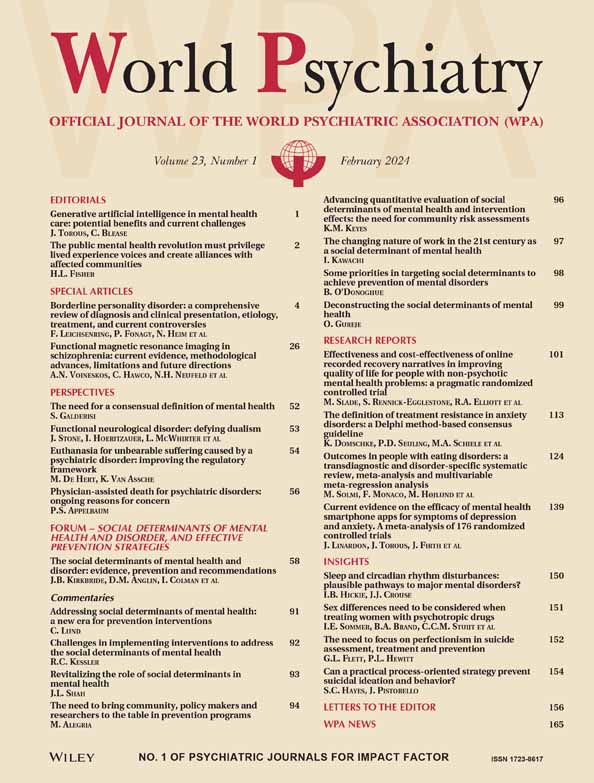Person‐centered measurement‐based care for depression
IF 65.8
1区 医学
Q1 PSYCHIATRY
引用次数: 6
Abstract
tic clinical utility. The recent emergence of low-cost pharmacogenomic techniques has sparked new interests in combinatorial use of allelic variations in drug transporters or metabolic genes as biomarkers that might predict drug response. An initial generation of research identified a number of candidate genes with apparent validity as predictors of treatment efficacy and treatment-related side effects. These candidates include genes implicated in serotonergic function, the ABC family of xenobiotic transporters located in the blood-brain barrier, and the cytochrome P450 detoxification enzymes. However, to date, there are no effective biological methods to objectively assess depression endophenotypes, severity, or treatment response. Previous efforts to achieve better treatment outcomes in psychiatry have led to the introduction of pharmacogenomics based decision-support tools, to help identify which patients are more or less likely to have a favorable outcome with specific pharmacotherapies, based on single nucleotide polymorphisms (SNPs) and gene variants in transporters and metabolizing enzymes. Genome-wide association studies have revealed that common genetic variations are unlikely to explain sufficient variance in treatment response to guide selection of treatment for individual patients. Rare gene variants have greater explanatory power than common variants, but such individual markers would likely apply to relatively few patients. Thus, if neither common nor rare gene variants are likely to have widespread predictive value as “stand alone” predictors of treatment response in typical clinical trials, a new strategy is needed, one that integrates several types of clinical and neurobiological markers to guide clinical decision making for depressive disorders. Since it is unlikely that a single biological alteration will have a one-to-one mapping with a DSM-defined or RDoCspecified mental phenomenon, a viable alternative to the single-biomarker approach is the development of biosignatures that aim to profile a diverse array of peripheral/serum growth factors, cytokines, hormones and metabolic markers. Additionally, integration with neurological, cognitive and psychological assessments will provide coverage of multiple abnormalities that contribute to the heterogeneity of depressive disorders. Such a biosignature will not only improve our ability to identify specific subtypes of depressive disorders, but will also assist with the selection of treatments that are likely to be more clinically useful. Based on this, some of the most promising variables to evaluate include: comprehensive clinical phenotype; magnetic resonance imaging using measures of cortical structure; diffusion tensor imaging to assess cortical white matter tract integrity; functional magnetic resonance imaging assessing brain activation patterns to both emotional conflict and reward-dependent learning tasks; quantitative electroencephalography (EEG) to assess cortical and subcortical brain activation patterns; cortical evoked EEG potentials; behavioral neuropsychological tasks to assess reaction time and motor processing speed; DNA, mRNA, and plasma, urine and saliva protein and metabolomics samples, collected at baseline and throughout the study; socio-economic, demographic and life habits parameters. Using this comprehensive approach, however, requires a large number of participants to be characterized in order to define subgroups in relation to treatment response. It also requires the use of effective computational tools to make integration of the wealth of knowledge generated from the diverse platforms possible. Herein lays our greatest challenge: developing large cohorts of depressed patients that will lead us to the discovery of not only new, meticulously-defined subtypes of depression, but also identification of precise treatments for each individual patient. If we are successful, this will propel the treatment of depression to equal the effectiveness of treatments for cancer and chronic heart disease.以人为本的抑郁症护理
临床应用。最近出现的低成本药物基因组学技术引发了人们对组合使用药物转运体或代谢基因中的等位基因变异作为可能预测药物反应的生物标志物的新兴趣。最初一代的研究确定了一些候选基因,这些基因明显有效地预测了治疗效果和治疗相关的副作用。这些候选基因包括涉及血清素能功能的基因,位于血脑屏障的外源转运蛋白ABC家族,以及细胞色素P450解毒酶。然而,到目前为止,还没有有效的生物学方法来客观地评估抑郁症的内表型、严重程度或治疗反应。为了在精神病学中获得更好的治疗结果,以前的努力已经导致了基于药物基因组学的决策支持工具的引入,以帮助确定哪些患者或多或少可能通过特定的药物治疗获得有利的结果,基于转运体和代谢酶的单核苷酸多态性(snp)和基因变异。全基因组关联研究表明,常见的遗传变异不太可能解释治疗反应的足够差异,从而指导个体患者的治疗选择。罕见的基因变异比常见的变异具有更强的解释力,但这样的个体标记可能适用于相对较少的患者。因此,如果在典型的临床试验中,常见和罕见的基因变异都不可能作为治疗反应的“独立”预测因素具有广泛的预测价值,那么就需要一种新的策略,一种整合几种临床和神经生物学标记的策略,以指导抑郁症的临床决策。由于单一生物变化不太可能与dsm定义的或rdoc指定的心理现象进行一对一的映射,因此单一生物标志物方法的可行替代方案是开发生物标记,旨在描述各种外周/血清生长因子,细胞因子,激素和代谢标记。此外,结合神经、认知和心理评估,将涵盖导致抑郁症异质性的多种异常。这样的生物标记不仅可以提高我们识别抑郁症特定亚型的能力,还可以帮助我们选择可能在临床上更有用的治疗方法。基于此,一些最有希望评估的变量包括:综合临床表型;使用皮质结构测量的磁共振成像;弥散张量成像评估皮质白质束完整性;功能磁共振成像评估情绪冲突和奖励依赖型学习任务的脑激活模式定量脑电图(EEG)评估皮层和皮层下脑激活模式;皮层诱发脑电图电位;评估反应时间和运动加工速度的行为神经心理学任务;在基线和整个研究过程中收集的DNA、mRNA、血浆、尿液和唾液蛋白质和代谢组学样本;社会经济、人口和生活习惯参数。然而,使用这种综合方法,需要对大量参与者进行特征描述,以便确定与治疗反应相关的亚组。它还需要使用有效的计算工具来整合来自不同平台的知识财富。这就是我们面临的最大挑战:发展大规模的抑郁症患者群体,这不仅将引导我们发现新的、精确定义的抑郁症亚型,而且还将确定针对每个患者的精确治疗方法。如果我们取得成功,这将推动抑郁症的治疗达到与癌症和慢性心脏病治疗一样的效果。
本文章由计算机程序翻译,如有差异,请以英文原文为准。
求助全文
约1分钟内获得全文
求助全文
来源期刊

World Psychiatry
医学-精神病学
自引率
7.40%
发文量
124
期刊介绍:
World Psychiatry is the official journal of the World Psychiatric Association. It is published in three issues per year.
The journal is sent free of charge to psychiatrists whose names and addresses are provided by WPA member societies and sections.
World Psychiatry is also freely accessible on Wiley Online Library and PubMed Central.
The main aim of World Psychiatry is to disseminate information on significant clinical, service, and research developments in the mental health field.
The journal aims to use a language that can be understood by the majority of mental health professionals worldwide.
 求助内容:
求助内容: 应助结果提醒方式:
应助结果提醒方式:


